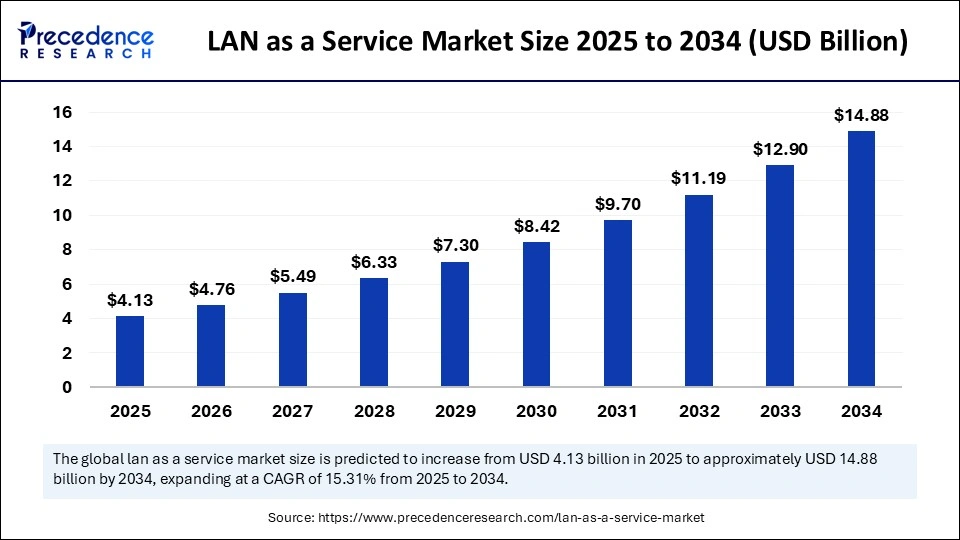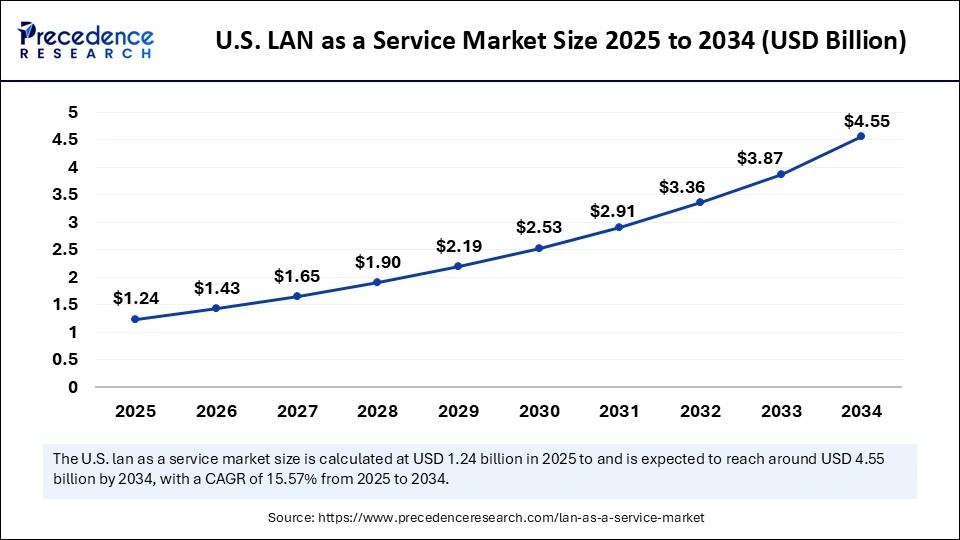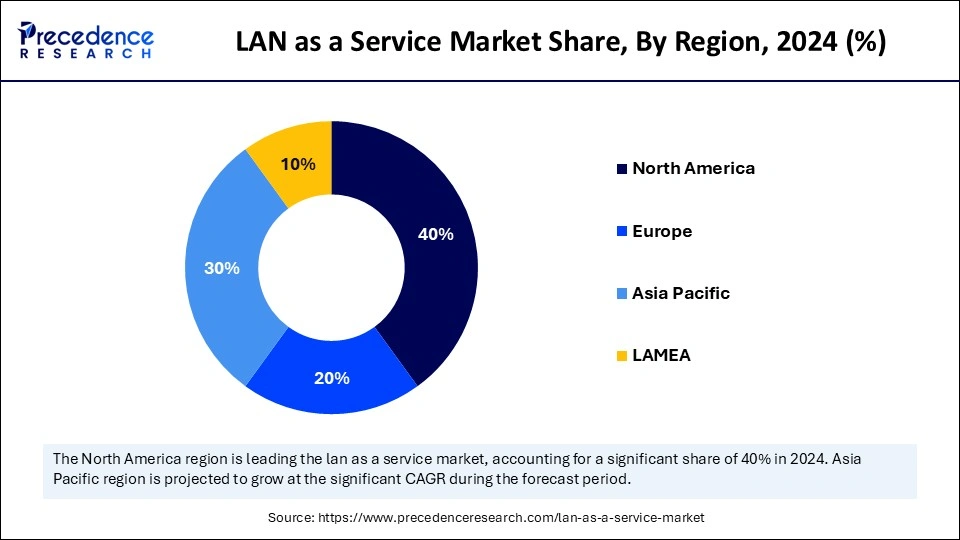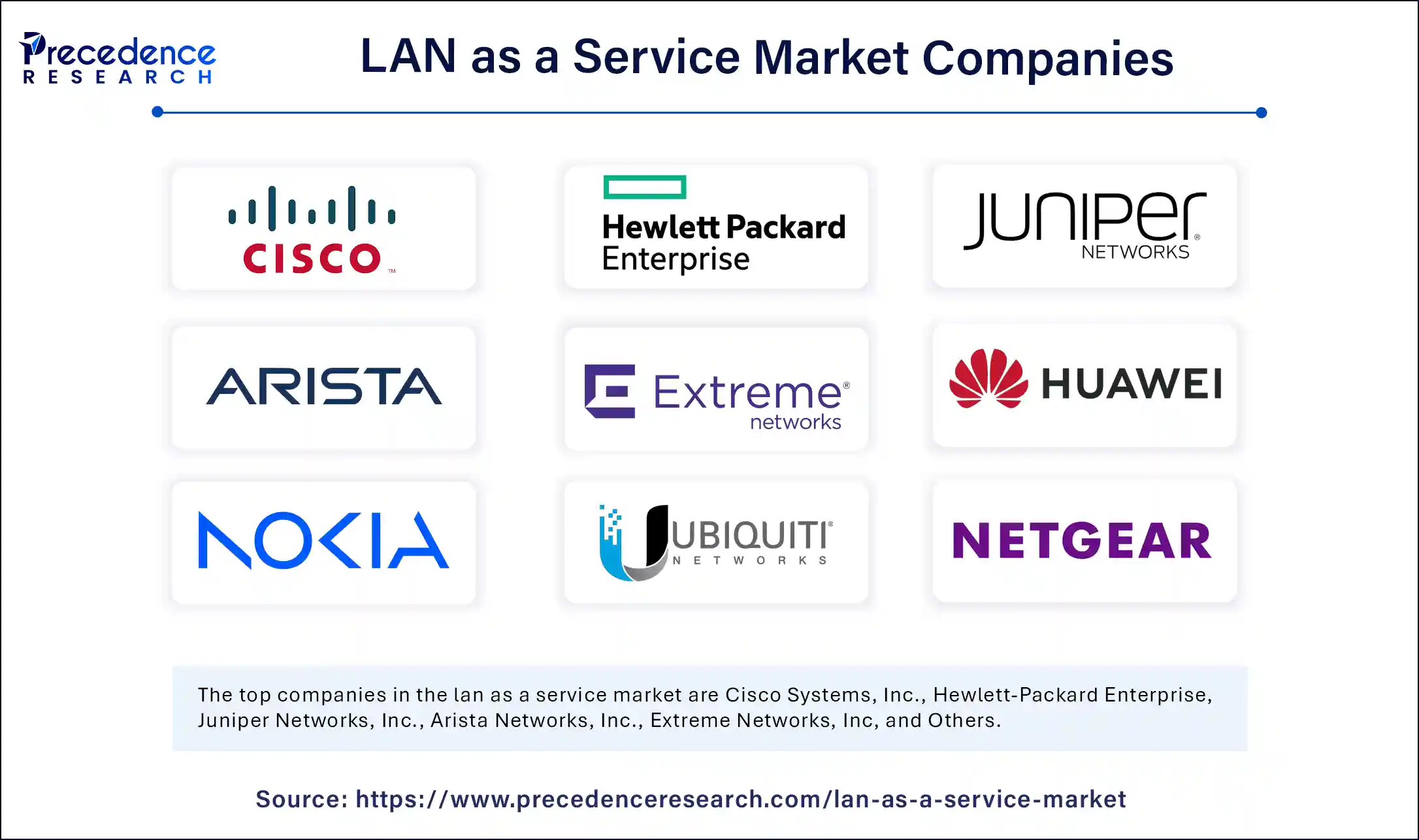List of Contents
LAN as a Service Market Size and Forecast 2025 to 2034
The global LAN as a service market size accounted for USD 3.58 billion in 2024 and is predicted to increase from USD 4.13 billion in 2025 to approximately USD 14.88 billion by 2034, expanding at a CAGR of 15.31% from 2025 to 2034. The increasing need for scalable and flexible networking solutions and the rapid adoption of cloud services contribute to the growth of the market.

LAN as a Service Market Key Takeaways
- In terms of revenue, LAN as a service market is valued at $4.13 billion in 2025.
- It is projected to reach $14.88 billion by 2034.
- The market is expected to grow at a CAGR of 15.31% from 2025 to 2034.
- North America dominated the LAN as a service market with the largest revenue share of 40% in 2024.
- Asia Pacific is expected to expand at the fastest CAGR during the forecast period from 2025 to 2034.
- By service type, the wired LAN segment dominated the market in 2024.
- By service type, the wireless LAN segment is projected to grow at a significant rate in the coming years from 2025 to 2034.
- By deployment model, the cloud-based segment dominated the market in 2024.
- By deployment model, the on-premises segment is expected to expand at a significant rate between 2025 and 2034.
- By enterprise size, the large enterprises segment dominated the market in 2024.
- By enterprise size, the SMEs segment is anticipated to witness significant growth in the upcoming period from 2025 to 2034.
How is AI Impact the LAN as a Service Market?
Artificial Intelligence AI is transforming the market for LAN as a Service by automating network management tasks. AI reduces the need for manual intervention in monitoring and troubleshooting, improving efficiency. AI has the ability to analyze network traffic to identify anomalies and detect security threats in real time. In addition, AI automates several tasks like network configuration, freeing up IT teams to focus on other core operations.
U.S. LAN as a Service Market Size and Growth 2025 to 2034
The U.S. LAN as a service market size was exhibited at USD 1.07 billion in 2024 and is projected to be worth around USD 4.55 billion by 2034, growing at a CAGR of 15.57% from 2025 to 2034.

Why Did North America Lead the LAN as a Service Market in 2024?
North America accounted for the highest revenue share of 40% in 2024. This is mainly due to the increased penetration of digitization and the availability of advanced technological infrastructure, supporting the seamless deployment of management of LAN service. North American businesses have increased utilization of cloud computing and storage services. The region is home to leading IT and networking solution manufacturers and providers, driving innovations and market growth. Growing cybersecurity concerns are pushing businesses to deploy their own private networks, supporting market expansion. In addition, stringent regulations regarding data security encouraged businesses to deploy LANaaS for enhanced security management.

Why Is Asia Pacific Experiencing Rapid Growth in the LAN as a Service Market?
Asia Pacific is expected to witness rapid growth during the projection period. This is mainly due to rising digitization. The region is witnessing significant growth in the number of SMEs that are seeking cost-effective solutions. Businesses in the region are adopting international standards of connectivity. China, India, Japan, and South Korea have established infrastructure for high-speed networks, facilitating the adoption of LANaaS. India plays a major role in the LAN as a service market within Asia Pacific. The rising government initiatives to promote digitization and the expansion of the IT industry are driving the growth of the market in India. In addition, increasing investment in IT infrastructure across the country is supporting the deployment of LANaaS.
Why Is Europe Emerging as a Key Market for LAN as a Service?
Europe is considered to be a significantly growing area. The growth of the LAN as a service market within Europe is attributed to its advanced technological infrastructure, which facilitates the seamless deployment of LANaaS. Businesses in the region are adopting LANaaS due to its flexibility, scalability, and cost-effectiveness. Stringent data privacy regulations encourage the adoption of LANaaS. Moreover, the rising demand for managed IT services among businesses and rapid digitization contribute to regional market growth.
Market Overview
LAN-as-a-Service (LANaaS) provides the required network setup and maintenance of a local area network for businesses. It is a service specifically dedicated to managing the network services for businesses. Having an in-house team for the maintenance of the network is quite expensive compared to outsourcing it. This is significantly increasing the popularity of LANaaS solutions. These solutions allow businesses to scale up or scale down their network as per requirements. LANaaS enables businesses to concentrate on their core operations while ensuring a seamless, high-speed, reliable, and cost-effective LAN network.
LAN as a Service MarketGrowth Factors
- The expansion of cloud computing and cloud storage in the business ecosystem is creating the need for high-speed and reliable networks, as many SaaS tools for business are cloud-based and require uninterrupted internet connectivity, contributing to the growth of the market.
- Technological advancements boost the growth of the market. Advanced technologies enhance LANaaS offerings by improving network performance, management, and security.
- The increasing demand for managed services is expected to boost the growth of the market.
- Seamless connection of local devices within the network, such as printers and scanners, allows resource sharing throughout the network, leading to proper utilization of resources. This encourages the adoption of LANaaS solutions.
- The growing awareness among consumers about the benefits of LANaaS supports market expansion. Users can share big files and data seamlessly throughout the high-speed LAN network with other users while maintaining data integrity.
Market Scope
| Report Coverage | Details |
| Market Size by 2034 | USD 14.88 Billion |
| Market Size in 2025 | USD 4.13 Billion |
| Market Size in 2024 | USD 3.58 Billion |
| Market Growth Rate from 2025 to 2034 | CAGR of 15.31% |
| Dominating Region | North America |
| Fastest Growing Region | Asia Pacific |
| Base Year | 2024 |
| Forecast Period | 2025 to 2034 |
| Segments Covered | Service Type, Deployment Model, Organization Size, and Region |
| Regions Covered | North America, Europe, Asia-Pacific, Latin America, and Middle East & Africa |
Market Dynamics
Drivers
No Need to Set Up an In-house Dedicated Team and Make an Investment in the Infrastructure
LAN as a service provides businesses with various advantages, such as cost savings, scalability and flexibility, and enhanced security. LANaaS solutions eliminate the need for upfront investments in hardware. This significantly reduces operational expenditure. While being cost-effective, LANaaS provides businesses with scalable solutions that can easily adapt to changing business requirements. This flexibility is only possible due to the LAN as a service. Due to its centralized control, it is easy to manage and monitor the network. This further reduces the burden on IT teams. LANaaS provides high security inside the network and prevents cyber threats, offering safe digital environments.
Restraint
Dependency on Internet Connectivity and Vendor Lock-in
Although LAN as a service provides businesses with many benefits, there are several factors that limit its adoption. LANaaS solutions require a stable and reliable internet connection for their smooth operation. Poor connectivity can disrupt network service and affect business operations. Thus, the lack of high-speed internet connection in some areas limits the adoption of LANaaS solutions. Another thing is the vendor lock-in, where businesses may find it difficult to switch to any other service provider. This can be problematic in cases where flexibility might be restricted, and options for customization are limited.
Opportunity
Increasing Demand for Cloud-based Solutions and Rapid Digitization
Businesses in the current times are using cloud-based tools and services instead of hosting them locally to reduce costs. Cloud-based solutions offer high-quality computing power and storage, so businesses don't have to invest in expensive hardware and software; they can avail it as per their requirements. This shift is creating immense opportunities in the LAN as a service market. Enterprises, educational institutes, and healthcare facilities are focusing on digital transformation. Digital platforms allow for easy scaling of LAN services to meet changing business needs. In addition, digitization enables remote management of LAN infrastructure, improving operational efficiency.
By Service Type Analysis
Why Did the Wired LAN Segment Dominate the LAN as a Service Market in 2024?
The wired LAN segment dominated the LAN as a service market in 2024. This is mainly due to its high speed, reliability, low latency rate, and high bandwidth. It has around 10 Gbps data transfer speed with around 1-4 ms latency rate. The data transfer reliability is very high in the wired LAN connectivity. It requires high-quality optical fiber or copper LAN cable to establish the network, which may be costly in the beginning but provides a stable network for long-term use. Meanwhile, the wireless LAN segment is projected to grow at a significant rate in the coming years. This is mainly due to its convenience and remote accessibility. Wireless LAN is more cost-effective, requires relatively less maintenance, and the installation is very easy and simple than wired LAN, making it the preferred choice.
By Deployment Model Analysis
Why Did the Cloud-Based Segment Dominate the LAN as a Service Market in 2024?
The cloud-based segment led the LAN as a service market in 2024. This is mainly due to the rapid shift of businesses toward cloud solutions due to their flexibility, high scalability, and cost-effectiveness. Technological advancements in cloud technology have made cloud resources readily available. Cloud-based solutions eliminate the businesses' need to invest in hardware, which significantly reduces operational expenditure. Moreover, cloud-based solutions allow businesses to scale up or down their resources as per requirements. Cloud solutions provide better network management and high flexibility in resource management.
On the other hand, the on-premises segment is expected to expand at a significant rate in the upcoming period. Increasing concerns over security is a major factor boosting the adoption of on-premises solutions. Since on-premises solutions are hosted on the organization's own infrastructure, they provide greater control over data. This, in turn, reduces the risks of data breaches.
By Organization Size Analysis
Why Did Large Enterprises Dominate the LAN as a Service Market in 2024?
The large enterprises segment led the LAN as a service market with the largest share in 2024 due to their increased connectivity needs. These organizations often deal with high volumes of data, requiring flexible and scalable solutions. LANaaS enables large organizations to quickly add or remove resources as per requirements. They require highly scalable and robust networking solutions to cater to changing business needs. On the other hand, the SMEs segment is anticipated to witness significant growth during the forecast period. The increasing demand for cost-effective solutions from SMEs is a key factor bolstering the growth of the segment. LANaaS eliminates the need for SMEs to invest in IT infrastructure, reducing operational costs. The rising adoption of cloud solutions among SMEs to scale up their operations further opens up new avenues for LANaaS.
Recent Developments
- In November 2025, Zayo, a leading US network, introduced managed LAN. For many years, Zayo has offered high-quality WAN solutions. Now they have started offering the LAN solution for enterprises. With this brand-new solution, Zayo has offered robust security in the local area network. With this, Zayo is offering Managed WiFi wireless LAN networking, and Managed Switches, wired Internet connectivity. (Source: https://www.zayo.com)
- In May 2025, Nokia launched a new Local Area Network (LAN) solution to reduce ownership costs for businesses looking to modernize their connectivity by up to 50%. The Aurelis Optical LAN can support speeds ranging from one gigabit per second (Gb/s) up to 25Gb/s, with Nokia suggesting it holds upgrade potential to reach 50Gb/s and 100Gb/s.
(Source:https://www.capacitymedia.com)
- In April 2025, Ericsson released wireless first branch architecture to provide Agile secure connectivity for AI-led enterprise innovations. New architecture is anchored by the Ericsson cradle point E400. It is the first enterprise application which combines 3gpp release 17 5G WiFi 7 and embedded e sim/dual sim. While reducing the complexity, it extends small and medium office LAN switches and Wi-Fi 6 access points seamlessly. Ericsson NetCloud manager is enabled with AI driven operations. It has centralised eSIM provisioning SD-WAN and zero trust security mechanism it has the capability to access 5G advanced networks slices. (Source: https://www.ericsson.com)
Key Players Operating in the Market

- Cisco Systems, Inc.
- Hewlett-Packard Enterprise
- Juniper Networks, Inc.
- Arista Networks, Inc.
- Extreme Networks, Inc.
- Huawei Technologies Co., Ltd.
- Nokia Corporation
- Ubiquiti Inc.
- Netgear, Inc.
- TP-Link Technologies Co., Ltd.
Segments Covered in the Report
By Service Type
- Wired LAN
- Wireless LAN
By Deployment Model
- Cloud-based
- On-premises
By Organization Size
- SMES
- Large Enterprises
By Region
- North America
- Europe
- Asia Pacific
- Latin America
- Middle East and Africa
For inquiries regarding discounts, bulk purchases, or customization requests, please contact us at sales@precedenceresearch.com
Frequently Asked Questions
Ask For Sample
No cookie-cutter, only authentic analysis – take the 1st step to become a Precedence Research client